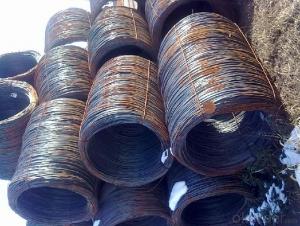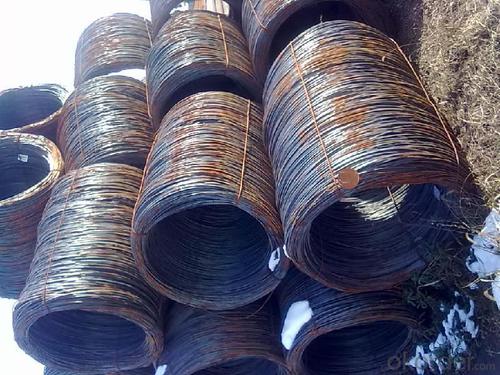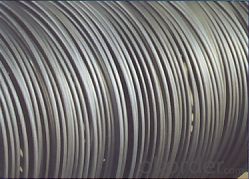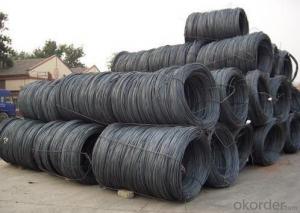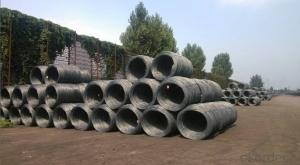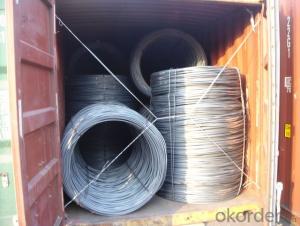hot rolled wire rod for construction GB Q235
- Loading Port:
- Tianjin
- Payment Terms:
- TT OR LC
- Min Order Qty:
- 25 m.t.
- Supply Capability:
- 100000 m.t./month
OKorder Service Pledge
OKorder Financial Service
You Might Also Like
Product Description:
Specifications of Hot Rolled Wire Rod:
Steel Grade: Q195/235, SAE1006-1018B Standard: ASTM, GB
Diameter: 5.5mm, 6.5mm, 7mm,8mm,9mm,10mm,12mm,14mm
Type: in coil, coil weight around 2MT Alloy or Not: Alloy
Technique: Hot Rolled Place of Origin: China Mainland
Surface: round, no twisted, light and smooth Brand Name: HSKY
Chemical Composition: (Please kindly find our chemistry of our material based on Q195、Q235A and Q235B as below for your information)
| Trademark | Rank | Chemical composition (quality score) % | ||||
| C | Si | Mn | S | P | ||
| ≤ | ≤ | ≤ | ||||
| Q195 | 0.06-0.12 | 0.30 | 0.25 | 0.050 | 0.045 | |
| Q235 | A | 0.14-0.22 | 0.30 | 0.30-0.65 | 0.050 | 0.045 |
| Q235 | B | 0.12-0.20 | 0.30 | 0.30-0.70 | 0.045 | 0.045 |
Usage and Applications of Hot Rolled Wire Rod:
After hot-rolled the products shaped into coil and delivery as finished product, including round, square, rectangular, hexagonal and so on. Since most of the products are round, it is generally called wire rod. Carbon steel wire rod is widely used in construction and manufacturing. Carbon steel wire rod is mainly used for reinforcement of reinforced concrete and welded structure or reprocessed (roberts , nail, etc.) materials, especially used to produce wire drawing, welding electrode, nails, spring, electronic, precise machinery parts and so on.
Packaging & Delivery of Hot Rolled Wire Rod:
Packaging Detail: products are packed in coil, each coil weight around 2 MT, and then shipped by container or bulk vessel
Delivery Detail: within 45 days after received deposit or LC.
Label: to be specified by customer, generally, each bundle has 1-2 labels
Trade terms: FOB, CFR, CIF
Hot Rolled Wire Rod in Container
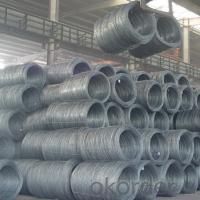
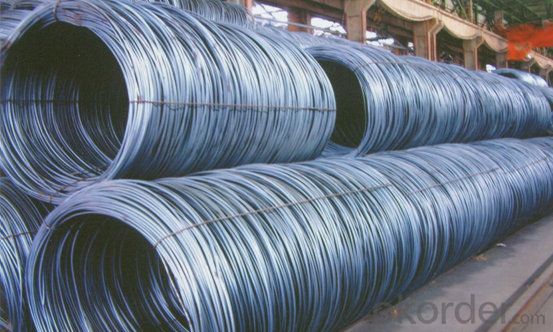
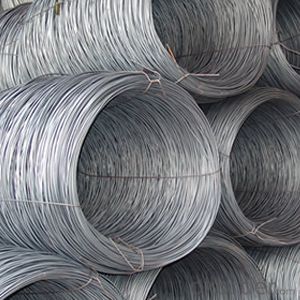
Note:
1. Our products are produced according to national standard (GB), if not, supply according to national standards (GB) or agreement as customer required.
2. Other Grade and Standard carbon steel wire rod we can supply:
Grade: H08A, 30MnSi, 62B-82B
Standard: AISI, BS, JIS, DIN
The Minimum Order Quantity of these products is high, and need to be confirmed.
3. We can not only supply carbon steel wire rod; if you need anything about building materials, please contact us.
4. Please send us your detail specifications when inquire. We will reply to you as soon as possible. We sincerely hope we can establish a long stable business relationship
- Q: How is steel wire rod used in the manufacturing of wire forms for signage?
- Wire forms for signage rely heavily on steel wire rod as a crucial element in their manufacturing process. The wire rod serves as the primary material for shaping and designing wire forms. To begin with, careful selection of the steel wire rod is based on its specific mechanical and chemical properties, such as tensile strength and resistance to corrosion. These properties guarantee the durability and ability of the wire forms made from the rod to withstand diverse weather conditions. Following the selection, the steel wire rod undergoes a series of manufacturing steps. Typically, the rod is drawn through a sequence of dies to reduce its diameter and increase its length. This wire drawing process enables the production of wires with precise dimensions and smooth surfaces. After achieving the desired thickness, the wire is further processed to create the specific shapes and forms required for signage. This may involve bending, coiling, or welding the wire into various configurations, depending on the design specifications. Once the wire forms are shaped using the steel wire rod, they are utilized in the manufacturing of signage. These wire forms often function as structural frameworks or supports for different types of signage, such as letters, logos, or decorative elements. They provide the necessary stability and rigidity to hold the signage in place, ensuring its integrity and visibility. Furthermore, the versatility of steel wire rod allows for the creation of intricate and complex wire forms that can be customized to meet specific design requirements. This design flexibility enables the production of visually captivating and distinctive signage, enhancing its aesthetic appeal and brand recognition. In conclusion, steel wire rod plays a vital role in the manufacturing of wire forms for signage. It serves as the raw material from which wire forms are shaped, providing the necessary strength and durability required for signage applications. The ability to customize wire forms allows for the creation of visually appealing and distinctive signage, making steel wire rod an indispensable component in the signage industry.
- Q: How is steel wire rod used in the manufacturing of wire forms for jewelry?
- Steel wire rod is a primary raw material used in the manufacturing of wire forms for jewelry. It serves as the base material from which various wire forms such as chains, clasps, and pendants are created. The steel wire rod is typically processed through a series of manufacturing techniques, including drawing and annealing, which help to shape and strengthen the wire. Once the wire forms are created, they can be further embellished with beads, gemstones, or other decorative elements to create intricate and unique jewelry pieces.
- Q: How is steel wire rod tested for chemical composition?
- Steel wire rod is tested for chemical composition through a process called spectroscopy. This involves using a spectrometer to analyze the wavelengths of light emitted or absorbed by the sample. By comparing these wavelengths to known standards, the composition of the steel wire rod, including the percentage of various elements like carbon, manganese, and silicon, can be determined accurately.
- Q: How is steel wire rod used in the manufacturing of wire ties for construction sites?
- Steel wire rod is an essential component in the manufacturing of wire ties for construction sites. These wire ties are widely used in the construction industry for various purposes, such as securing rebar, reinforcing concrete structures, and fastening construction materials together. The steel wire rod serves as the raw material for producing wire ties. It undergoes a series of processes to transform it into the final product. First, the wire rod is cleaned and coated to enhance its corrosion resistance. This coating, often made of zinc, provides an added layer of protection against rust and ensures the wire tie's longevity in harsh construction environments. Next, the coated steel wire rod is fed into a wire drawing machine where it is pulled through a die to reduce its diameter to the desired size. This process is repeated several times to achieve the required wire thickness and strength. Once the wire is drawn to the desired gauge, it is then cut into appropriate lengths to produce individual wire ties. These lengths can vary depending on the specific application and requirements of the construction project. The wire is then bent, twisted, or formed into the shape of a tie using specialized machinery. Wire ties made from steel wire rod offer exceptional strength, durability, and flexibility. They can be easily bent or twisted to fit around various construction materials, ensuring a secure and tight connection. Moreover, the high tensile strength of steel wire rod ensures that the wire ties can withstand considerable stress and load without breaking or deforming. The wire ties manufactured from steel wire rod are commonly used in construction sites to secure and fasten rebar during concrete pouring. They are also used to reinforce concrete structures, such as walls, columns, and beams. Additionally, wire ties are employed to bundle or tie together construction materials, including pipes, cables, and electrical wires, ensuring proper organization and preventing potential hazards. In summary, steel wire rod plays a crucial role in the manufacturing of wire ties for construction sites. These wire ties provide essential support and reinforcement in various construction applications, offering durability, flexibility, and strength to ensure the safety and stability of construction projects.
- Q: What are the common machining methods for steel wire rod?
- The common machining methods for steel wire rod include cutting, drilling, threading, and bending.
- Q: How is the bending properties of steel wire rod tested?
- The bending properties of steel wire rod can be tested by subjecting it to a bending test, where the rod is bent to a specified angle and checked for any signs of cracking, deformation, or failure. This test helps determine the flexibility and strength of the wire rod under bending forces.
- Q: How is steel wire rod used in the manufacturing of wire hangers?
- Steel wire rod is used in the manufacturing of wire hangers as it serves as the primary raw material. The wire rod is first drawn through a series of dies to decrease its diameter and increase its strength. This process creates the thin, sturdy wire that is then shaped into the desired hanger form. The steel wire rod's strength and flexibility make it an ideal material for producing reliable and durable wire hangers.
- Q: How is steel wire rod used in the manufacturing of wire forms for sliding doors?
- Steel wire rod is used in the manufacturing of wire forms for sliding doors as it provides the necessary strength and durability required for these applications. The steel wire rod is shaped and formed into various wire forms such as tracks, brackets, and hinges, which are essential components of sliding doors. These wire forms help to ensure smooth and effortless movement of the doors, providing stability and support.
- Q: What are the common applications of low alloy and oil tempered steel wire rod?
- Various industries commonly utilize low alloy and oil tempered steel wire rod due to its wide range of applications. One such application is found in the manufacturing of automotive components. These steel wire rods are essential for producing springs, including suspension springs and valve springs, which play a crucial role in ensuring the proper functioning of vehicles. Their exceptional strength and durability make them well-suited for enduring the demanding conditions and heavy loads experienced by automobiles. Additionally, the construction industry relies on low alloy and oil tempered steel wire rod for a multitude of purposes. Reinforcing bars, also known as rebars, are fabricated from these steel wire rods and are indispensable for reinforcing concrete structures such as buildings, bridges, and highways. The strength and ductility of these steel wire rods guarantee that the reinforced structures can withstand the stresses and pressures they encounter, thereby providing stability and longevity. Moreover, low alloy and oil tempered steel wire rod finds extensive application in the manufacturing of various industrial equipment and machinery. Wire ropes, commonly used in cranes, elevators, and other lifting equipment, are frequently made from these steel wire rods. Their high tensile strength and resistance to corrosion make them suitable for withstanding heavy loads and harsh environments. Furthermore, low alloy and oil tempered steel wire rod is also utilized in the production of wire mesh, fencing, and other wire products. The strength and durability of these steel wire rods ensure that the wire products can endure external forces and provide security or containment in diverse settings, such as construction sites, agricultural fields, and industrial facilities. Overall, low alloy and oil tempered steel wire rod is widely employed in the automotive, construction, industrial, and wire product sectors. Its unique properties, including high strength, durability, and resistance to corrosion, make it a versatile material that contributes to the functionality and reliability of various products and structures.
- Q: How is steel wire rod used in the manufacturing of wire for power generation systems?
- Steel wire rod is a crucial component in the manufacturing of wire for power generation systems as it serves as the raw material used to produce high-quality wires. These wires are then utilized in various applications within power generation systems, such as electrical transmission lines, cables, and conductors. The strength, durability, and conductivity of steel wire rod make it ideal for ensuring efficient power transmission and reliable performance in these systems.
Send your message to us
hot rolled wire rod for construction GB Q235
- Loading Port:
- Tianjin
- Payment Terms:
- TT OR LC
- Min Order Qty:
- 25 m.t.
- Supply Capability:
- 100000 m.t./month
OKorder Service Pledge
OKorder Financial Service
Similar products
Hot products
Hot Searches
Related keywords
